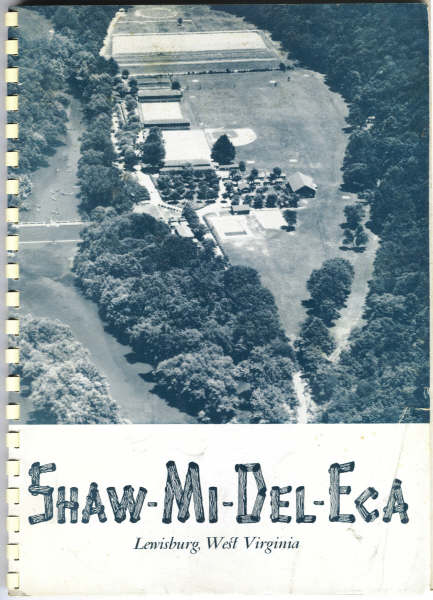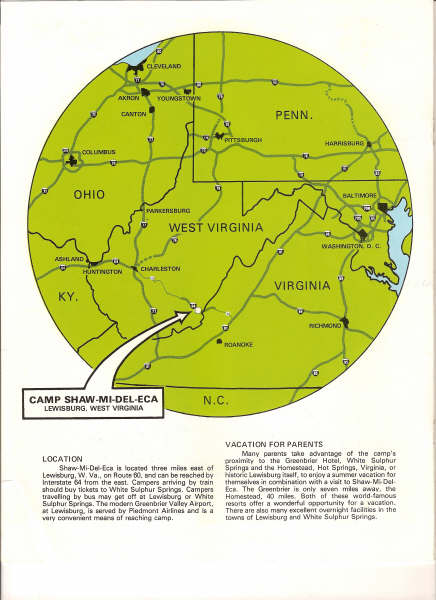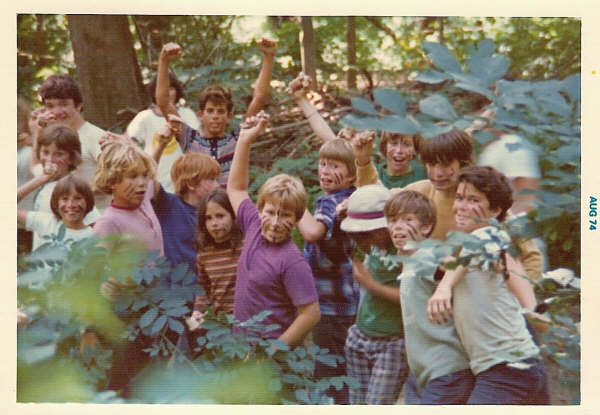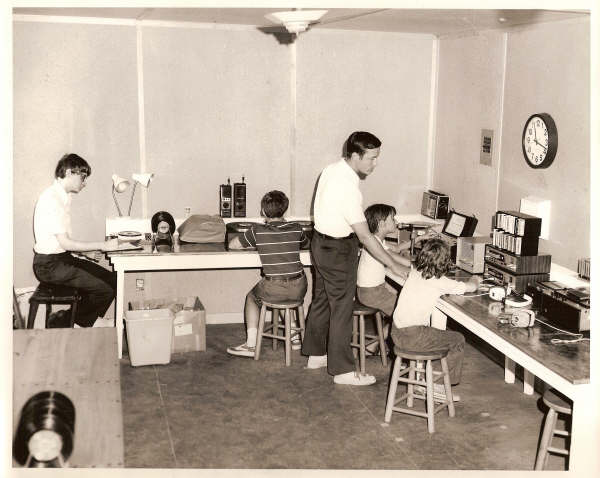

Covers of Camp Shaw-Mi-Del-Eca Promotional Catalogs


Electronic Mail:
< shaw-mi@planetarium.cc >
Internet Address of this Web Site:
<
https://johnbrashear.tripod.com/shaw-mi.html >
Camp Shaw-Mi-Del-Eca (the name is an abbreviation for four Indian tribes that existed in the region prior to the Nineteenth Century: Shawnee, Miami, Delaware, and Seneca) was operated as a Summer camp from 1929 through 1978. From 1929 through 1971 it was operated as a Summer camp for boys by the Greenbrier Military School in Lewisburg, West Virginia U.S.A.--although, the Summer camp was not operated as a military camp[other military academies, such as the Valley Forge Military Academy in suburban Philadelphia(Wayne, Pennsylvania), does operate a Summer camp, which is a military-style camp]. In May of 1972, when the Greenbrier Military School went out-of-business (this news made the national media, including the NBC-TV "Today" show), it was also feared that Camp Shaw-Mi-Del-Eca would go out-of-business as well--only about a month and a half before the 1972 camping season was scheduled to begin! However, at the "last moment," Camp Shaw-Mi-Del-Eca was purchased and operated as a Summer camp for boys and girls by a local Lewisburg physician, Dr. Eugene McClung; an emergency letter was sent to recent camp attendees alerting them that the Camp would remain open. In 1978, a s Florida couple purchased the Camp and operated it for one year, before it closed permanently.
The author was employed with Shaw-Mi-Del-Eca, Incorporated, as a Camp Counselor and as General Manager of the Camp's radio station, WLCR-AM Carrier Current, during the Summers of 1972 through 1977. The author was also a camper at Camp Shaw-Mi-Del- Eca, as well as a staff member of the Camp radio station, during the Summers of 1967 through 1971.


Camp Shaw-Mi-Del-Eca was located in Greenbrier County, West Virginia U.S.A., which borders the Commonwealth of Virginia on the County's eastern boundary. Of course, prior to the Civil War, Greenbrier County was located in Virginia. And, although Greenbrier County was included in the new State of West Virginia, many of the residents of Greenbrier County had sympathies for the Confederate cause.
Camp Shaw-Mi-Del-Eca was located on the the eastern shore of the Greenbrier River, just outside of the little village of Caldwell, West Virginia U.S.A.; the even smaller village of North Caldwell (which was best known for a flea market each Saturday) is located on the western side of the Greenbrier River. The Camp location is three miles east of Lewisburg, the county-seat for Greenbrier County. The location is also six miles west of White Sulphur Springs, the location of the world-renowned resort called " The Greenbrier." The Greenbrier had been owned by the Chesapeake and Ohio Railroad, which constructed a passenger railroad station immediately across the street from the resort; this rairoad station is now used by the National Railroad Passenger Corporation (AMTRAK) for thrice-weekly passenger rail service to White Sulphur Springs from Washington, Cincinnati, and Chicago.
In a 1992 news story, "The Ultimate Congressional Hideaway," by investigative reporter Ted Gup in The Washington Post Magazine, it was revealed that a bunker, for the protection of high-level Federal Government officials, including the entire U.S. Congress, in the case of a nuclear holocaust, had been constructed under The Greenbrier property in the late 1950s. Although this bunker, known as Project Greek Island, was a Government secret for many years, some local residents had a vague awareness of its presence, prior to the official announcement. More information: Link 1 *** Link 2 *** Link 3

The Camp Shaw-Mi-Del-Eca property ran in a flat plain from the Greenbrier River east to "Goat Mountain," and from U.S. Route 60 (the entrance to the Camp) north to the present location of Interstate Route 64; Interstate 64 was constructed several years prior to the closing of the Camp. A fair-sized island, in the Greenbrier River, was included in the Camp property.
A dam was built between the main Camp property and the island, to allow a fair depth of water in the smaller river channel(between the Camp and the island) for canoeing and kyacking by the campers. About 150 feet downriver from the main dam was a smaller dam, which created a smaller, more shallow pool of water.
There was a very narrow walkway, on the main dam, which provided the only dry access to the island from the Camp-proper. Campers would walk across the dam, single-file, to travel between the island and the Camp-proper. Although the larger dam was the primary access point, betwe en the main Camp and the island, the smaller dam (which had only a small amount of water flowing over the top of it) was also occasionally used for access.
The river channel, between the main Camp and the island, had been used for swimming in the Camp's early years, before a swimming pool was constructed. By the 1950s, the Camp had constructed its own swimming pool, located near the Camp entrance, across the main Camp road from the Warrior Camp cabins (which became the girls' Camp cabins in 1972). The river channel was then used for swimming only occasionally. Longtime counselor, Granville Shirley of Bunker Hill (Berkeley County), West Virginia, was in charge of the Camp's swimming program throughout the 1960s and 1970s.
A few times each summer, even in the Camp's later years, the campers would take trips riding inner tubes on the Greenbrier River, starting at Camp Alleghany (girls' summer camp a few miles north/upriver of Camp Shaw-Mi-Del-Eca) and concluding at the Camp's smaller river channel.
Much of the Camp's flat plain, as well as the island, was flooded in June of 1972, following Hurricane Agnes, which devastated much of the northeastern portion of the United States. This flooding just started to subside with the opening of the 1972 camping season; the 1972 camping season was not delayed.
Hurricane Agnes was one of the worst storms of the 1970s. Although northeastern Pennsylvania was the hardest hit, even Pittsburgh encountered its greatest flood since the great flood of Saint Patrick's Day in 1936. Due to flood control measures constructed in the 1950s, the flooding from Hurricane Agnes was not anywhere near as devastating to Pittsburgh as the floods of 1936 or 1907 December. In 1972, the city's largest downtown park, Point State Park(located where the Allegheny and Monongahela Rivers converge to form the Ohio River), was flooded as well as some basements of downtown buildings, including the Joseph Horne Company Department Store. On the North Side, the North Shore riverfront park, as well as the area around and inside of the recently-built(1970 June) Three Rivers Stadium(then, home of the National League baseball Pirates and the National Football League Steelers) was also flooded in 1972. In the 1936 flood, more than half of Downtown Pittsburgh and the city's Lower North Side was flooded!
Camp Shaw-Mi-Del-Eca operated a seven-week resident camping season, from the last week in June through the first week in August. Campers also had the option of just attending half of the normal camp session: three and one-half weeks. Day-campers, from the Greenbrier County area, were also accomodated. Outside of the normal camp session, special camp sessions were held including Band Camp (including high school bands from all over the state of West Virginia) in the late Spring and a Family Camp in August. During the 1970s(after Dr. McClung purchased the Camp), a two-week session was held in mid-June for impoverished children of Appalachia; a Federal Government grant paid for this special session.
Camp Shaw-Mi-Del-Eca was not the only camp for young people in Greenbrier County. Camp Greenbrier was a camp for boys near Alderson. Camp Alleghany was a camp for girls, a few miles north of Camp Shaw-Mi-Del-Eca, also on the eastern shore of the Greenbrier River. Camp Ann Bailey was a camp operated by the Girl Scouts of America, just north of Camp Shaw- Mi-Del-Eca, also on the eastern shore of the Greenbrier River; Interstate 64 was constructed through this camp property, necessitating the closing of this camp in 1974. These camps, occasionally, participated in activities together, including dances.
While Camp Ann Bailey used the post office in the small village of Caldwell, Camp Shaw-Mi-Del-Eca always used Lewisburg for their post office. Of course, Camp mail came through the Lewisburg post office while the Camp was owned by the Greenbrier Military School, which was located in Lewisburg. When Lewisburg physician Dr. Eugene McClung bought the Camp in 1972, Camp mail continued being posted through the Lewisburg post office, via Post Office Box 747.
During its time, Camp Shaw-Mi-Del-Eca was considered one of the leading private camps in the country. In addtion to attracting campers from West Virginia and Virginia, Camp Shaw-Mi-Del-Eca attracted campers from several eastern and mid-western cities including Washington, Baltimore, Pittsburgh, Richmond, Norfolk, Columbus, and Cincinnati. In its hey-day, the Camp would receive a passenger rail car full of campers from the Norfolk and Richmond areas, as well as a bus load of campers from the Columbus area(particularly the suburb of Upper Arlington). Some campers also came from outside of the United States. In particular, a few campers came from the West Indies nation of the Dominican Republic, on the island of Hispaniola which was discovered by Christopher Columbus in 1492; the Greenbrier Military School also had several students from the Dominican Republic.
The increasing costs of operating a private camp, particularly liability
insurance and food, eventually led to the camp closure. After the conclusion of a Camp staff meeting, Dr. McClung once said, only half-jokingly, that
he had to get back to his physician's office and see more patients, to help pay for the camp!
Infrastructure maintenance costs also contributed to the high cost of operating Camp Shaw-Mi-Del-Eca. As one of the nation's older Summer camps, having started in 1929, Camp Shaw-Mi-Del-Eca had a much greater infrastructure than other Summer camps, including a swimming pool, a river dam to provide an area for canoeing and kayaking (and, originally swimming, before the swimming pool was built), as well as pretty substantial cabins for the campers. Many other Summer camps of that era did not have such a substantial infrastructure.
The camp day began at 8:00 a.m. every day except Sunday, when Reveille was sounded at 8:30 a.m. Reveille in the morning and Taps in the evening were played by long-time campers Quinton Robinson of Winchester, Virginia (during the 1967 camping season, although he attended the Camp from 1963-1967) and Ted W. Bernstein of Martinsburg, West Virginia (1971-1976), two of the few campers who played the bugle.
Taps was blown at different times in the evening, as the different age groups of campers went to bed at different hours. The youngest group of campers(ages 7-9), called the Warriors, went to bed the earliest (9:30 p.m.). The Pioneers(ages 10-11), Pathfinders(ages 12-13), and Explorers(ages 14-16) went to bed at later times (Pioneers: 10:00 p.m., Pathfinders and Explorers: 10:30 p.m.). If a camper wished to continue at camp past age 16, he or she could become a Counselor-in-Training(no pay, but no annual Camp admission fee either); the following year, he or she could be hired as a Counselor, becoming a Senior Counselor after being employed for a few years.
To the right is a 1947 photograph of Camp Shaw-Mi-Del-Eca camper Doug Fisher, showing the camp logo on the T-shirts issued to campers (CLICK HERE to see a larger image of the photograph of Mr. Fisher at camp in 1947). In a Wednesday Evening, 2020 April 22 electronic mail message to the author (Glenn A. Walsh), Mr. Fisher, who is now 82 years-old and living in Florida and Virginia, says he loved the camping experience, where he learned how to canoe and swim.
Each week, the campers were provided with a stamped picture postcard [picture on the card was of a camp view or event], so they could write a brief message to their parents. This mandatory errand ensured that parents heard from their children attending camp at least once per week. And, the fact that the message had to be written on this postcard was no accident. This allowed the camp counselors to review the postcards before mailing, to learn if a camper in the counselor's cabin had a major problem that they were writing about to their parents [that the counselor or the camp may not be aware of].
There were three meals in the Camp's Dining Hall. A "mid-morning lunch" was also provided around 10:45 a.m., at a special concession stand-type facility. This small building was across the Camp road from the cement pond, where captured fish, frogs, turtles, and other creatures were kept during the Camp season (including a cement island in the middle of the pond). At the mid-morning lunch, outside, Campers were given small cartons of milk and a small snack; many campers remember the milk cartons from RIPCO (Roncerverte Ice and Produce Company), which often included a picture and brief biography of a President of the United States.
For much of the 1970s, the author was the Counselor responsible for assigning campers to raise the American flag(just prior to the campers being seated for breakfast) and lowering the American flag(just prior to the campers being seated for dinner). The flag pole was situated just outside of the Camp Administration Building(between the Administration Building and the Infirmary); this building was located across the street (one-lane street, primarily used by camp vehicles) from the Dining Hall. The one-lane street included a speed-bump, between the Administration Building and the Dining Hall, to slow the speed of vehicular traffic. The author was also responsible for assigning campers to say Grace in the Dining Hall, prior to each meal.
When Camp Shaw-Mi-Del-Eca became co-ed in 1972 (with the transfer of ownership from the Greenbrier Military School to Eugene McClung, M.D.), the girls were housed in the former Warrior Camp cabins, which were the group of cabins closest to the Camp entrance (and across the street from the swimming pool). Warriors were then combined into the Pioneer Camp, the cabins farthest north along the Greenbrier River. A few years before the camp closure, some of the original Camp cabins in the Pioneer Camp, which had been constructed on stilts at the edge of the top of the steep river bank, were demolished. The Pathfinders and Explorers were housed in cabins just southeast of the Dining Hall; this group of buildings also included the all-purpose assemblage hall, which had a small stage.


Near the end of the Camp season, there was another major competition which was a mini-Olympics-type event. This included all of the competitive Camp activities. The pins that campers received, from this competition, were issued by the President's Council on Physical Fitness and Sports. Another major activity, near the end of the Camp season, was the annual talent show which occurred on the stage of the all-purpose building, in the middle of the Pathfinder/Explorer Camp.
Camp Shaw-Mi-Del-Eca included all of the normal Summer camp activities such as Riflery, Archery, Horseback Riding, Hiking and Camping, Tennis, Golf (often the campers would play at the golf course of The Greenbrier, where Sam Sneed was the resident golf pro; once, campers golfing at The Greenbrier found a golf ball with the logo of Pittsburgh radio station KDKA, the nation's first commercial radio station), Canoeing, Kyacking, Swimming (with instruction on how to swim), Basketball [National Basketball Association(NBA) legend John Havlicek, who played for the Boston Celtics from 1962-1978, was a Camp Counselor in the mid-1960s] , Woodworking, Crafts, and the Martial Arts. Tutoring was also available to campers, for an additional charge.

As with most Summer camps, Nature Study was included as a regular activity. A visit to a West Virginia state fish hatchery, in White Sulphur Springs, is an example of one of several field trips campers attended. However, Camp Shaw-Mi-Del-Eca was different from most camps in that it also provided activities in the Physical Sciences.
The primary Physical Science activity was Radio, including the operation of an AM Carrier Current radio station, WLCR, which allowed the campers to broadcast their own radio programs. Instruction in the basic fundamentals of radio and in the requirements for obtaining a Federal Communications Commission(FCC) commercial radio operator's license was provided. Several campers, after successfully completing the FCC radio license examination, received a Third Class Commercial Radiotelephone License with Broadcast Endorsement; five of these campers completed this test at the FCC office in Washington, shortly after the end of the Camp season in August of 1975(while in Washington, these campers toured the Voice of America studios).

This historic event was seen on a hazy television picture from the only television channel that could be received over-the-air: NBC-TV affiliate WHIS-TV 6 in Bluefield, West Virginia, about 60 miles south of the Camp[Later on, an educational television station(channel 9) from the Grandview/Beckley, West Virginia area could also be received, for area residents outside of Camp who did have television. To receive any other television channels(from Charleston, West Virginia or Roanoke, Virginia) required cable television which, of course, the Camp did not subscribe to.]. Although there were no televisions in the Camp, a few campers and counselors, who did have FM radios, could listen to the audio portion of WHIS-TV on the lowest end of the FM radio band, since television channel 6 borders on the 88 MegaHertz section of the FM radio band.
Later-on, in the late Summer of 1972, The Radio Group/WLCR-AM Carrier Current radio statiion did receive the donation of an old VHF-TV-only (manufactured prior to 1964 April 30) color television from the Camp management (McClung family), but it was not kept beyond that Summer. One Sunday morning, long after sunrise, the author was surprised to receive the audio (only) of two distant television stations on this relatively old television receiver: KMID-TV 2 in Midland Texas and WBRZ-TV 2 Baton Rouge, Louisiana.
A few other Physical Science activities, most of them associated with The Radio Group (the group of campers involved with the Camp radio station), were also provided. These included Rocketry, Photography(a dark- room was installed one Summer), Astronomy, and Meterology(one Summer, the author arranged for the Camp to receive a used Weather station and equipment; the Camp became an official substation of the National Weather Service).
History of WLCR-AM Carrier Current: The Camp Radio Station
WLCR-AM Carrier Current
Radio Station Announcements
Facebook Page: Camp Shaw-Mi-Del-Eca Alumni
History of the Greenbrier Military School (Owner of Camp Shaw-Mi-Del-Eca: 1929 to 1972)
Remembrances - General HIstory
Camp Advertisement in Greenbrier Military School newspaper Green-Briars, 1932 June 1
1940s --- Carolyn Harris, Camp Business Manager from 1948 to early 1970s *** View of Camp and Camp Entrance, Looking from Goat Mountain
Canoes on Lake Weotowe *** Swimming Below the Dam *** Tribal Chief
1950s --- Tribal Chiefs (1954) *** Tribal Chiefs (1957)
"Nation's first golf course to be auctioned today in White Sulphur Springs."
The State Journal, Charles ton WV 2012 July 28.
1884 golf course (not affiliated with The Greenbrier) not operated between 1910 and 1994.
Walsh, Glenn A.
"The Historic Mission of Apollo 11
Man Walks on the Moon for the First Time
A Personal Remembrance From 40 Years Ago."
History of Buhl Planetarium Web Site 2009 July 20.
<
http://buhlplanetarium2.tripod.com/bio/Apolloremembrance.htm >.
Remembrance of watching first manned Moon landing at Camp Shaw-Mi-Del-Eca.
Levy, David H.
"A 1967 Meteor Watch."
Sky and Telescope Magazine On-Line 2009 May 22.
Astronomy program at a boy’s summer camp near Honesdale, Pennsylvania.
History of the
Amateur Transmitters' Association of Western Pennsylvania,
which was the primary Pittsburgh-area amateur ("ham") radio club from 1926 through the late 1990s,
and which met for many years at Pittsburgh's original
Buhl Planetarium and Institute of Popular Science.
The Saturday Light Brigade,
Weekly family/children's radio program, including periodic radio workshops for children,
aired on educational radio station
WRCT-FM 88.3 of
Carnegie Mellon University in Pittsburgh,
with studios in the Lower Level of Pittsburgh's
historic Buhl Planetarium building.
National Radio Club
World's oldest and largest club of medium wave (AM Band) distance radio listeners; formed in 1933.
New Swimming Pool Built in the 1950s
(Photograph Courtesy: Steve Callaghan)
Four photographs showing:
Dining Hall (upper left of page)
Four Totem Poles, for each of the Camp's four tribes: Shawnee, Miami, Delaware, Seneca (upper right of page)
Cement Pond and Island, used for Nature Study--included fish and other wildlife caught by campers (lower left of page)
One of the newer cabins (1970s) in the combined Warrior/Pioneer Camp (lower right of page)
(Photographs Courtesy: Steve Callaghan)
Cover - With Aerial Photo of Camp Shaw-Mi-Del-Eca
(Courtesy: K.C. Hoffman)
Crafts Including Radio
(Courtesy: K.C. Hoffman)
Field Trip to Green Bank Radio Telescopes
(Courtesy: K.C. Hoffman)
Basketball
(Courtesy: K.C. Hoffman)
Group Photos of Each Camp: 1964 Campers
(Courtesy: K.C. Hoffman)
Camping References for Parents of Prospective Campers (1965 Catalog)
(Courtesy: K.C. Hoffman)
1975 Catalog
Cover - With Several Photographs
(Courtesy: K.C. Hoffman)
Inside Cover - Photo of Council Circle Near Goat Mountain
(Courtesy: K.C. Hoffman)
Camp Photos Including Field Trips to Green Bank Radio Telescopes and Bluestone Lake
(Courtesy: K.C. Hoffman)
Horseback Riding
(Courtesy: K.C. Hoffman)
Sports: Basketball, Golf, Archery, Riflery
(Courtesy: K.C. Hoffman)
Water Sports: Scuba Diving, Kyaking, Water Skiing, Canoeing, Swimming
(Courtesy: K.C. Hoffman)
Judo Instruction, Tutoring, Two Nurses Outside Infirmary, Four Totem Poles
(Courtesy: K.C. Hoffman)
Map of Camp Shaw-Mi-Del-Eca, Photo of Mountain Hike
(Courtesy: K.C. Hoffman)
Map to Camp Shaw-Mi-Del-Eca
(Courtesy: K.C. Hoffman)
Rear Cover - Photo of Campers Canoeing on Greenbrier River (Camp's Back Channel)
(Courtesy: K.C. Hoffman)
List of Camp Counselors for 1973 Camping Season
(Courtesy: Steve Callaghan)
Camping References for Parents of Prospective Campers (1965 Catalog)
(Courtesy: K.C. Hoffman)
Magazine Advertisment for 1938 Camping Season
(Courtesy: K.C. Hoffman)
History of WLCR-AM Carrier Current: The Camp Radio Station
WLCR-AM Carrier Current
Radio Station Announcements
Walsh, Glenn A.
"The Historic Mission of Apollo 11
History of The Buhl Planetarium and
Institute of Popular Science, Pittsburgh -
History of The Adler Planetarium
and Astronomy Museum, Chicago -
History of Andrew Carnegie and Carnegie
Libraries
History of The Duquesne
Incline, Pittsburgh -
Quick-Reference Pages(Valuable Library References)
This Internet, World Wide Web Site administered by Glenn A.
Walsh.
This Internet web page was originally created 2001 August 12.
Man Walks on the Moon for the First Time
A Personal Remembrance From 40 Years Ago."
History of Buhl Planetarium Web Site 2009 July 20.
<
http://buhlplanetarium2.tripod.com/bio/Apolloremembrance.htm >.
Remembrance of watching first manned Moon landing at Camp Shaw-Mi-Del-Eca.
More information.
Other Internet Web Sites of Interest
History of Astronomer, Educator, and
Optician John A. Brashear
Including the Oldest Operable, Major Planetarium Projector in the World !
America's First Major Planetarium !
Historic Cable Car Railway Serving Commuters and Tourists since 1877 !
Ninth Pennsylvania
Reserves Civil War Reenactment Group,
Henry Buhl, Jr.
Planetarium and Observatory,
The
Carnegie Science
Center, The
Carnegie Museums of Pittsburgh/Carnegie Institute,
or
The Carnegie Library of Pittsburgh.
Unless otherwise indicated, all pages in this web site are
Copyright
2001-2023,
Glenn A. Walsh, All Rights Reserved.
The author thanks
The Carnegie Library of
Pittsburgh and the Three Rivers Free-Net
for use of their digital scanner and
other computer equipment, and other
assistance provided in the production of this web site.
Web address of this web page: <
https://johnbrashear.tripod.com/shaw-mi.html >
Contact Web Site Administrator:
shaw-mi@planetarium.cc
Last modified : Monday, 19-Aug-2024 01:39:48 EDT.
You are visitor number , to this web page,
since 2001 August 12.